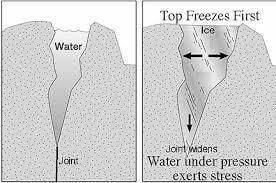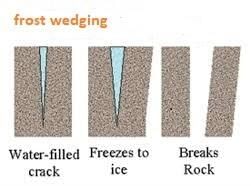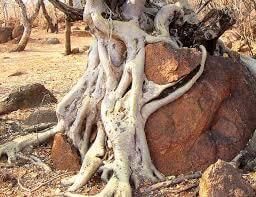Exogenetic Forces | Geography for UPSC CSE PDF Download
Exogenic Forces: Denudation & Weathering
- Geomorphic processes are classified into endogenic processes and exogenic processes.
- Exogenic (Exogenetic) processes are a direct result of stress-induced in earth materials due to various forces that come into existence due to the sun’s heat.
- Force applied per unit area is called stress. Stress is produced in a solid by pushing or pulling.
- The basic reason leads to weathering, erosion, and deposition in the development of stresses in the earth’s materials' body.
- Temperature and precipitation are the two important climatic elements that control various processes by inducing stress in earth materials.
Denudation
- All the exogenic geomorphic processes are covered under a general term, denudation.
- The word ‘denude’ means to strip off or to uncover.
- Weathering, mass wasting/movements, erosion, and transportation are included in denudation.
- Denudation mainly depends on rock type and its structure that includes folds, faults, orientation and inclination of beds, presence or absence of joints, bedding planes, hardness or softness of constituent minerals, chemical susceptibility of mineral constituents; the permeability or impermeability, etc.
- The effects of most of the exogenic geomorphic processes are small and slow but will, in the long run, affect the rocks severely due to continued fatigue. Question for Exogenetic ForcesTry yourself:Which one of the following processes is responsible for the weathering of rocks in a Karst region?
View Solution
Denudation:- 4 Phases
- Weathering
- Erosion
- Transportation
- Deposition
Weathering
- Weathering is the disintegration of rocks, soil, and minerals under the influence of physical (heat, pressure) and chemical (leaching, oxidation and reduction, hydration) agents.
- As very little or no motion of materials takes place in weathering. It is an Insitu disintegration or breakdown of rock material.
- The weathered material is carried farther away by erosion.
There are three major groups of weathering processes:
- Physical or mechanical
- Chemical
- Biological
Mechanical Weathering
Physical weathering involves mechanical disintegration of rocks due to temperature changes, freeze-thaw cycles, wet-dry cycles, crystallization of salts, animal and plant activity, etc.
Various mechanisms of mechanical weathering are explained below.
Exfoliation due to pressure release or unloading
- Intrusive igneous rocks formed deep beneath the Earth’s surface are under tremendous pressure due to overlying load.
- Removal of the overlying load because of continued erosion causes vertical pressure release with the result that the upper layers of the rock expand and fracture parallel to the surface.
- Over time, rock sheets break away from the exposed rocks along the fractures, a process known as exfoliation.
- Exfoliation due to pressure release is also known as “sheeting“.
Exfoliation due to thermal stress weathering
- Thermal stress weathering results from the subsequent expansion and contraction of rocks caused by diurnal and seasonal variations in the temperatures.
- The surface layers of the rocks tend to expand more than the rock at depth, leading to peeling off the surface layers (exfoliation).
- This process is most effective in dry climates and high elevations, where diurnal temperature changes are drastic.
- Although temperature changes are the principal driver, moisture can enhance thermal expansion in rock.

Granular Disintegration
- Granular disintegration happens in rocks composed of different types of coarse-grained minerals.
- Dark-coloured minerals absorb more heat than the light-coloured minerals.
- This leads to differential expansion and contraction of mineral grains, resulting in grain separation from the rock.

Frost weathering
- During the warm season, the water penetrates the pore spaces or fractures in rocks.
- During the cold season, the water freezes into ice, and its volume expands as a result.
- This exerts tremendous pressure on rock walls to tear apart even where the rocks are massive.
- Frost weathering occurs due to ice growth within pores and cracks of rocks during repeated cycles of freezing and melting.
- Frost weathering is the collective name for several processes where ice is present.
- These processes include frost shattering, frost-wedging, and freeze-thaw weathering.

Frost wedging
- Freeze wedging is caused by the repeated freeze-thaw cycle.
- Cracks filled with water are forced further apart with subsequent freezing and thawing.

Shattering
- Severe frost can disintegrate rocks along weak zones to produce highly angular pieces with sharp corners and edges through the process of shattering.
- Shattering piles up rock fragments called scree at the foot of mountain areas or along slopes.

Block Separation (freeze-thaw weathering)
Repeated freeze-thaw cycles weaken the rocks, which break up along the joints into angular pieces over time. The splitting of rocks along the joints into blocks is called block disintegration.
Salt Weathering
- Salt weathering occurs when saline solutions seep into cracks and joints in the rocks and evaporate, leaving salt crystals behind.
- Salt crystals expand during the crystallization process and also when they are subjected to above normal temperatures.
- The expansion in near-surface pores causes splitting of individual grains within rocks, eventually falling off (granular disintegration or granular foliation).
- Salt weathering is normally associated with arid climates where strong heating causes strong evaporation and crystallization.

Role of Physical Weathering
- Reduces rock material to smaller fragments that are easier to transport
- Increases the exposed surface area of rock, making it more vulnerable to further physical and chemical weathering
Chemical Weathering
- Chemical weathering involves chemical decomposition of rocks and soil.
- Chemical weathering processes include dissolution, solution, carbonation, hydration, oxidation, and reduction that act on the rocks to decompose, dissolve or reduce them to a fine state.
- These weathering processes are interrelated and go hand in hand and hasten the weathering process.
- Acids produced by microbial and plant-root metabolism, water and air (oxygen and carbon dioxide), and heat speed up all chemical reactions.
- Water is the main operator:
- Dissolution:
(i) Many ionic and organic compounds dissolve in water
(ii) Silica, K, Na, Mg, Ca, Cl, CO3, SO4
(iii) H2O + CO2 + CaCO3 → Ca+2 + 2HCO3-
(iv) water + carbon dioxide + calcite dissolves into calcium ion and bicarbonate ion - Acid Reactions
(i) Water + carbon dioxide ⇔ carbonic acid
(ii) Water + sulfur ⇔ sulfuric acid
(iii) H+ effective at breaking down minerals

➤ There are several types of Chemical Weathering:
- Hydrolysis and oxidation:
- Hydrolysis is the most important chemical weathering process due to the dissociation of H2O into H+ and OH- ions that chemically combine with minerals and bring about changes, such as exchange, decomposition of crystalline structure and formation of new compounds. Water acts as a weak acid on silicate minerals.
- Oxidation is the reaction of a substance with Oxygen.
- Acid Action:
- Chemical weathering is also produced by acid action, most commonly Carbonic Acid. Carbon dioxide gets dissolved in water to form a weak acid. A day since the concentration of Sulphur oxides and Nitrogen oxides is increasing in the atmosphere because of the burning of fossil fuels, the acidity of the rain has also increased. Carbonate sedimentary rocks, especially limestone and marble, are highly susceptible to this type of weathering.
- Acid rain is also harmful to architectural structures, especially made of marble.
Biological Weathering
Biological weathering is the weakening and subsequent disintegration of rock by plants, animals, and microbes. It can occur due to physical stress like penetration of plant’s roots, the physical impact of the animal's hooves, etc. or due to chemical changes caused by them like the action of worms, lichens, etc.

Mass Wasting
Mass wasting, also known as slope movement or mass movement, is the geomorphic process by which soil, sand, regolith, and rock move downslope typically as a mass, largely under the force of gravity, but frequently affected by water and water content as in submarine environments and mudflows.
Landslide
A landslide is the movement of rock, debris or earth down a slope. They result from the failure of the materials that make up the hill slope and are driven by gravity. Landslides are also known as landslips, slumps or slope failure.
➤ Types of landslide Movements:
- Falls are masses dislodged from very steep slopes or escarpments, free-fall, bounce, or roll downslope. Falls usually move extremely rapidly.
- Topples are a forward rotation around a pivot point low or below one or more masses.
- Lateral spreads are the result of movement involving lateral extension accommodated by shear or tensile fractures. This type of movement is earthquake-induced.
- Slides displace masses along one or more discrete planes. Slides may either be rotational or translational in their movement.
- Rotational movement is where the plane is curved. The mass rotates backwards around a common point with an axis parallel to the slope.
- Translational movement is where the plane is more or less planar or gently undulating. The mass moves roughly parallel to the ground surface.
- Flows are masses moving as a deforming, viscous unit without a discrete failure plane. Question for Exogenetic ForcesTry yourself:Consider the following statements:
1. Crystallization is a form of mechanical weathering.
2. Hydration causes granular disintegration.
3. Frost action is synonymous with freeze-thaw action.
Which of the statements given is/above are correct?
View Solution
➤ Causes of Landslides:
- Natural Causes:
- Groundwater pressure acting on the slope.
- Loss of vegetation
- Weakening of slope due to melting of the glacier or heavy rainfall
- Earthquakes
- Volcanic eruptions
- Human Causes:
- Vibrations from machinery
- Blasting of mines
- Earthwork which alters the slope
- Construction, agriculture or forestry activities which can affect the amount of water entering the soil
Prevention of Landslides:
Many methods are used to remedy landslide problems. The best solution, of course, is to avoid landslide-prone areas altogether.
Listed below are some common remedial methods used when landslide-prone slopes cannot be avoided.
Improving surface and subsurface drainage: Because water is the main factor in landslides, improving surface and subsurface drainage at the site can increase the stability of a landslide-prone slope. Surface water should be diverted away from the landslide-prone region by channelling water in a lined drainage ditch or sewer pipe to the slope's base. The water should be diverted in such a way as to avoid triggering a landslide adjacent to the site. Surface water should not be allowed to pond on the landslide-prone slope.
Excavating the head: Removing the soil and rock at the head of the landslide decreases the
driving pressure and can slow or stop a landslide. Additional soil and rock above the landslide will need to be removed to prevent a new landslide from forming upslope. Flattening the slope angle at the top of the hill can help stabilize landslide-prone slopes.
Buttressing the toe: If the toe of the landslide is at the base of the slope, the fill can be placed over the toe and along the slope's base. The fill increases the resisting forces along the failure surface in the toe area. This, in turn, blocks the material in the head from moving toward the toe.
Constructing piles and retaining walls: Piles are metal beams driven into the soil or placed in drill holes. Properly placed piles should extend into a competent rock layer below the landslide. Wooden beams and telephone poles are not recommended for use as piles because they lack strength and rot.
Removal and replacement: Landslide-prone soil and rock can be removed and replaced with stronger materials, such as silty or sandy soils.
Preserving vegetation: Trees, grasses, and vegetation can minimize the amount of water infiltrating into the soil, slow the erosion caused by surface-water flow, and remove water from the soil.
Rockfall protection: Rockfalls are contained by (1) ditches at the base of the rock exposure, (2) heavy-duty fences, and (3) concrete catch walls that slow errant boulders that have broken free from the rock outcrop.
Erosion
Erosion is the act in which earth is worn away, often by water, wind, or ice. It is an ex-situ process where an external agent is involved. The fragments break because of external impact, i.e. kinetic energy, unlike weathering where only gravity is involved.
The rocks are broken at one place, and the broken particles are carried by the agents to far distances and are deposited.
It is the most destructive process shaping the tertiary reliefs.
Agents of Erosion
There are broadly five agents which cause erosion and carve distinct landforms:
- Running surface water – The landforms made by surface streams are called fluvial landforms.
- Wind – these landforms are formed in arid and semi-arid regions where the wind's action is dominating. These landforms are called Aeolian.
- Glaciers – Glaciers carve these landforms in high alpine mountains.
- Waves – They are formed by the action of waves on the edge of the continent.
- Karst – These landforms are formed by the action of underground water on the Karst or Limestone region.
|
175 videos|472 docs|197 tests
|
FAQs on Exogenetic Forces - Geography for UPSC CSE
| 1. What are exogenic forces? |  |
| 2. What is denudation? |  |
| 3. What is the difference between weathering and erosion? |  |
| 4. How do exogenic forces contribute to the formation of landforms? |  |
| 5. What are the main factors affecting denudation processes? |  |

|
Explore Courses for UPSC exam
|

|

















